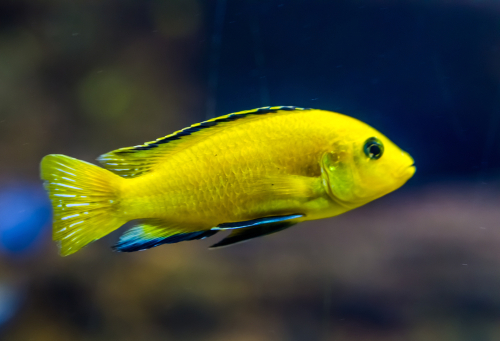Named for their bright yellow bodies, electric yellow cichlids are one of the smaller species in the cichlid families. Also known as yellow labs for their scientific name Labidochromis caeruleus, these vibrant fish add a splash of color to any aquarium, provided you know how to keep them happy and healthy.
Keep in mind that cichlids are omnivorous and will prey on certain tank mates, such as small, slow-moving aquatic species like shrimp. The best Electric Yellow Cichlid Tank Mates are:
- Rainbow fish
- Featherfin catfish
- Giant danios
- Keyhole cichlids
- Clown loach
- Bristlenose Plecos
- Zebra cichlids
- Blue Orchid Peacock cichlids
- Dragonblood Peacock cichlids
- Rusty cichlids
- Yellow Tail Acei cichlids
- Upside Down Catfish
Read on to learn more about these 12 species and why they make good tank mates for electric yellow cichlids.
Contents
Electric Yellow Cichlid Tank Mates: What you Need to Know
As with any pet, it’s important to do your research and learn what electric yellow cichlids need to thrive in an aquatic community, as well as the needs of any potential tank mates.
Temperament
Unlike other cichlids, electric yellow cichlids are peaceful rather than aggressive and therefore have more options in tank mates than other, more aggressive cichlid species.
This isn’t to say that they aren’t territorial. Like all fish, particularly cichlids, electric yellows need their space and will act aggressively if crowded. They are also omnivorous and will prey on any species slow enough to catch and small enough to fit in their mouths.
Size
Electric yellow cichlids are among the smaller cichlid species, with a maximum adult size of between 3 – 4 inches in length.
Competition
The minimum group size for these fish is one male to two females. Never place more than one male cichlid in the group, though more than two females can coexist peacefully within the group.
Water Parameters and Tank Setup
Electric yellow cichlids need hard water with a hardness level between 15 – 20, with a slightly basic pH between 7.7 – 8.5. It goes without saying that any tank mates need to be able to thrive in the same water parameters.
Despite electric yellow cichlids being among the smaller cichlid varieties, they are relatively territorial and need plenty of space. Even the most peaceful fish species will become stressed when crowded and act aggressively towards tank mates.
The ideal tank size for electric yellow cichlids is 50 gallons, with 40 gallons being the absolute minimum.
The Best Electric Yellow Cichlid Tank Mates
While most cichlid species do best with other cichlids, there are a few species that coexist well with electric yellows.
More posts in a similar category:
- Golden Wonder Killifish Tank Mates
- Firemouth Cichlid Tank Mates
- Green Terror Tank Mates
- Blue Crayfish Tank Mates
1. Turquoise Rainbow Fish

- Scientific Name: Melanotaenia Iacustris
- Adult Size: 5 inches
- Compatible with: cichlids, plecos, catfish, barbs, gobies, and danios
- Water Temperature: 66 – 67 degrees Fahrenheit
- Minimum tank size: 30 gallons
- Care Level: Beginner
- Origin: Lake Kutubu, Papua New Guinea
These vibrant blue fast-moving fish thrive in hard water and are a great match for the peaceful, relatively shy electric yellows. Their bright blue color with green undertones complements the electric yellow cichlids’ eye-catching hue.
Pros:
- colorful
- a beautiful addition to a community tank
- relatively easy to care for
Cons:
- happiest in aquariums with lots of vegetation, which can mean extra aquarium maintenance
- fast, active movements can stress slower aquarium species
2. Featherfin Catfish
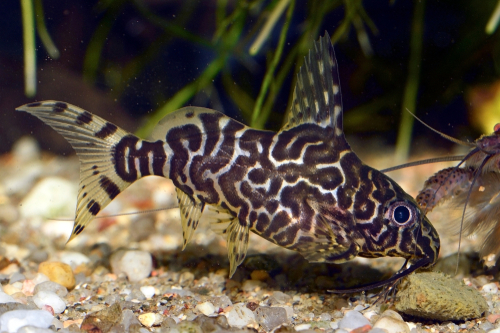
- Scientific Name: Synodontis eupterus
- Adult Size: 10 inches
- Compatible with: community tank with no small fish
- Water Temperature: 71 – 78 degrees Fahrenheit
- Minimum tank size: 50 gallons
- Care Level: Intermediate
- Origin: Central Africa
Also known as the featherfin squeaker, this catfish is named for its long, flowing fins. Its contrasting colors are either black, brown, or dark gray with white, cream, or light brown with mottled spots.
Pros:
- flashy, eye-catching appearance
- adaptable
- relatively easy to care for
Cons:
- needs plenty of hiding places to thrive
3. Giant Danios
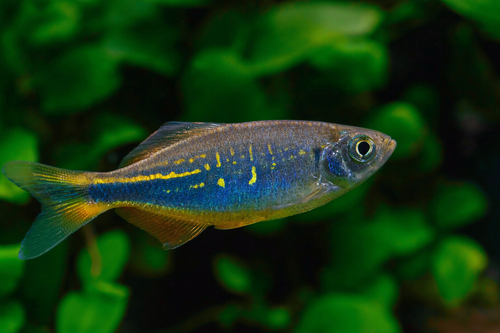
- Scientific Name: Devario aequipinnatus
- Adult Size: 4 inches
- Compatible with: community tank with other fast-moving, active species
- Water Temperature: 72 – 75 degrees Fahrenheit
- Minimum tank size: 30 gallons
- Care Level: easy
- Origin: Southeast Asia
These colorful, fast-moving fish are best kept in aquariums with lots of live plants. Their bodies are usually silver with undertones of multiple other colors such as blue, orange, pink, yellow, and green. They often have horizontal stripes running down the sides of their bodies.
Pros:
- versatile
- easy to care for
Cons:
- may stress slower, more docile species with their constant activity and rapid movements
- needs lots of live plants, which means extra aquarium maintenance
4. Keyhole Cichlid
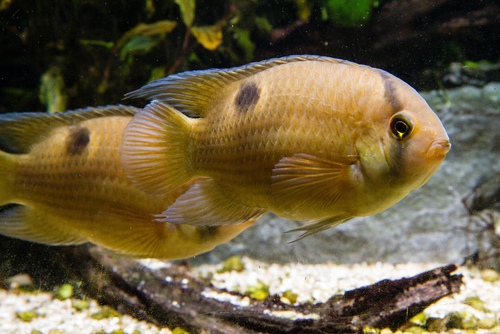
- Scientific Name: Cleithracara maronii
- Adult Size: 4 – 5 inches
- Compatible with: other docile, peaceful fish of similar size
- Water Temperature: 68 – 82 degrees Fahrenheit
- Minimum tank size: 20 gallons
- Care Level: Easy
- Origin: South America
These peaceful fish have a similar size and disposition to electric yellow cichlids. Their bodies are brown with irregular black stripes running vertically down the sides.
Pros:
- peaceful
- shy
- easy to care for
- can thrive in smaller tank than other cichlids
Cons:
- because they’re slow, may be stressed by fast-moving species in the same tank
5. Clown Loach
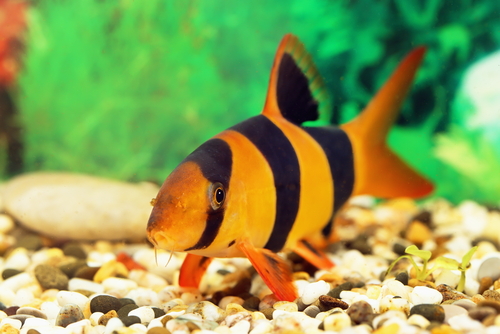
- Scientific Name: Botia macracantha
- Adult Size: 12 inches
- Compatible with: other peaceful fish
- Water Temperature: 75 – 85 degrees Fahrenheit
- Minimum tank size: 100 gallons
- Care Level: Moderately difficult
- Origin: Indonesia
This goofy-looking fish with prominent stripes is an eye-catching species with an orange and black striped body with red fins. They can grow quite large – sometimes up to 12 inches – and require a large tank, but many aquarium hobbyists consider the extra maintenance worth it.
Even though the clown loach is larger than electric yellow cichlids, they are peaceful and won’t prey on them.
Pros:
- visually striking
- peaceful
Cons:
- can grow quite large
- needs a big tank
- moderately difficult to take care of
6. Bristlenose Plecostomus
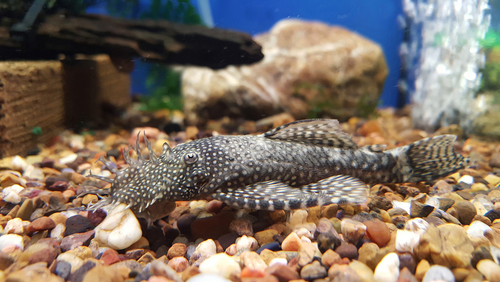
- Scientific Name: Ancistrus cirrhosus
- Adult Size: 5 inches
- Compatible with: community tanks
- Water Temperature: 73 – 81 degrees Fahrenheit
- Minimum tank size: 40 gallons
- Care Level: Easy
- Origin: Central and South America
Also known as bushy nose plecos, these distinctive fish are bottom feeders and help keep your tank clean by regularly sucking the substrate and consuming particles of algae, detritus, and uneaten food. Their bodies are usually a mottled dull brown color.
Pros:
- helps keep tank clean
- easy to feed
- much smaller than other pleco species
- fun to have in aquarium
Cons:
- herbivorous, may have different feeding needs than other fish in the tank
7. Zebra Cichlid
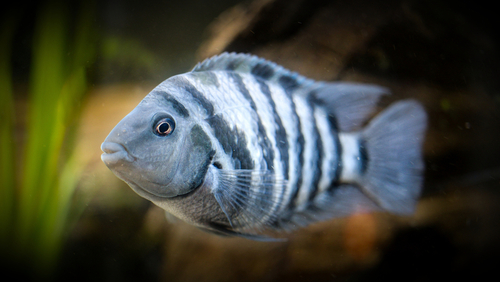
- Scientific Name: Metriaclima callainos
- Adult Size: 8 inches
- Compatible with: other cichlids and fast-moving fish of similar size
- Water Temperature: 77 – 82 degrees Fahrenheit
- Minimum tank size: 50 gallons
- Care Level: Difficult
- Origin: Lake Malawi, Africa
This cichlid species is named for its vibrant stripes and is often known as the convict cichlid for its black and white stripes. While this cichlid is a bit bigger than the electric yellow cichlid, sometimes growing twice the size of the electric yellow, its peaceful disposition will usually prevent it from attacking.
Pros:
- peaceful
- among the smaller cichlid species
Cons:
- can be aggressive towards slower-moving fish
- difficult to care for
8. Blue Orchid Peacock Cichlid
- Scientific Name: Aulonocara kandeense
- Adult Size: 4.5 – 7 inches
- Compatible with: other cichlids and fast-moving fish of similar size
- Water Temperature: 77 – 82 degrees Fahrenheit
- Minimum tank size: 55 gallons
- Care Level: Easy
- Origin: Lake Malawi, Africa
This peaceful cichlid is named for its vibrant blue hue. The body is a light to medium blue with darker blue stripes running vertically down both sides. It is one of the smaller cichlid species and has a peaceful disposition similar to that of the electric yellow cichlid.
Pros:
- easy to care for
- visually striking
- smaller than other cichlid species
- relatively peaceful
Cons:
- can be aggressive with slower and smaller fish
9. Dragonblood Peacock Cichlid
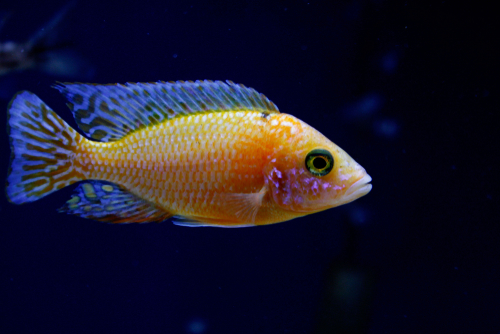
- Scientific Name: Aulonocara sp.
- Adult Size: 7 inches
- Compatible with: other cichlids of similar size
- Water Temperature: 77 – 82 degrees Fahrenheit
- Minimum tank size: 100 gallons
- Care Level: Intermediate
- Origin: Lake Malawi, Africa
The striking red hue of this fish lends it this distinctive name. It is believed that the dragonblood peacock cichlid was originally bred from the gold peacock cichlid and the red peacock cichlid.
Pros:
- easy to care for
- visually striking
- smaller than other cichlid species
Cons:
- needs a large tank
- can be aggressive, especially with smaller, slow-moving fish
10. Rusty Cichlid

- Scientific Name: lodotropheus sprengarae
- Adult Size: 3 – 4 inches
- Compatible with: other peaceful fish of similar size
- Water Temperature: 77 – 82 degrees Fahrenheit
- Minimum tank size: 55 gallons
- Care Level: Easy
- Origin: Lake Malawi, Africa
This African cichlid species has a pale orange – or rust – colored body. It is sexually dimorphous, and the male rusty cichlid has a purplish belly. It is one of the smaller cichlid species and is very compatible with the electric yellow cichlid due to its less aggressive nature.
Pros:
- easy to care for
- peaceful
- one of the smaller cichlid species
Cons:
- can be territorial
- will prey on slower, smaller fish
11. Yellow Tail Acei Cichlid
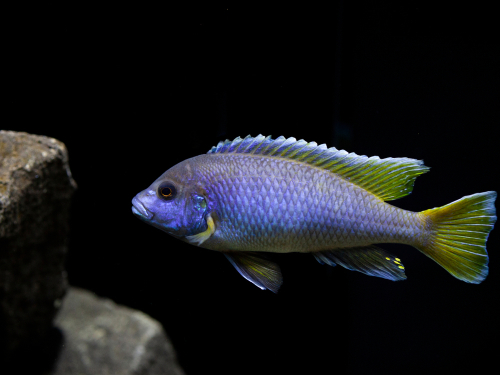
- Scientific Name: Pseudotropheus elegans
- Adult Size: 6 inches
- Compatible with: other cichlids of similar size, especially Mbuna cichlids
- Water Temperature: 74 – 82 degrees Fahrenheit
- Minimum tank size: 70 gallons
- Care Level: Intermediate
- Origin: Lake Malawi, Africa
This lovely cichlid is small, growing to a maximum adult size of 6 inches, and has a striking blue body with bright yellow fins – though occasionally the fins are white. Its beautiful color complements that of the electric yellow cichlid nicely and makes for an eye-catching aquarium pet.
Pros:
- smaller cichlid
- beautiful color
- peaceful disposition
Cons:
- needs a large tank, at least 70 gallons
- can be difficult to care for
12. Upside Down Catfish

- Scientific Name: Synodontis nigriventris
- Adult Size: 3 – 4 inches
- Compatible with: community tank with peaceful fish; smaller cichlids
- Water Temperature: 72 – 79 degrees Fahrenheit
- Minimum tank size: 10 gallons
- Care Level: Easy
- Origin: Central Africa
This catfish with the odd name is a bottom feeder, so it’s very beneficial to your aquarium by keeping your tank and substrate clean. The upside down catfish is a peaceful species and is fun to watch, named because it often floats around belly up. Its body is light brown with black or dark brown spots or blotches.
Pros:
- small
- peaceful
- a fun addition for an aquarium
- easy to care for
Cons:
- will kill any fish that tries to eat it by erecting the sharp spines on its body

Ian Sterling, founder of Fishlab.com, began his aquarium journey over 30 years ago, driven by a deep fascination for fish and their diverse personalities. His website, Fishlab.com, is dedicated to making fishkeeping accessible and enjoyable, offering beginner-friendly guidance, expert insights, and a community for aquarists to connect and share experiences.


